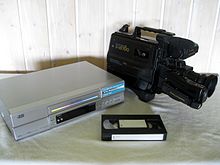 | |
 Top view of a VHS videocassette | |
| Media type | Magnetic cassette tape, ½-inch |
|---|---|
| Encoding | FM on magnetic tape; NTSC, PAL, SECAM, MESECAM; 525 lines; 625 lines |
| Capacity | In minutes. Common for PAL: 120, 180, 240. Common for NTSC: 120, 160. |
| Read mechanism | Helical scan |
| Write mechanism | Helical scan |
| Developed by | JVC (Victor Company of Japan) |
| Dimensions | 18.7 × 10.2 × 2.5 cm (71⁄9 × 4 × 1 inch) |
| Usage | Home video and home movies (replaced by DVD and Blu-ray), TV recordings (replaced by DVR) |
| Extended from | Compact cassette |
| Released | September 9, 1976 (Japan) August 23, 1977 (United States) Lifespan: 1976–2011; 35 years (Japan) 1977–2008; 31 years (United States) 1980–2006; 26 years (Australia) |

The VHS (Video Home System)[1][2][3] is a standard for consumer-level analog video recording on tape cassettes, introduced in 1976 by the Victor Company of Japan (JVC). It was the dominant home video format throughout the tape media period in the late 1970s, 1980s, and 1990s.[4][5]
Magnetic tape video recording was adopted by the television industry in the 1950s in the form of the first commercialized video tape recorders (VTRs), but the devices were expensive and used only in professional environments. In the 1970s, videotape technology became affordable for home use, and widespread adoption of videocassette recorders (VCRs) began;[6] the VHS became the most popular media format for VCRs as it would win the "format war" against Betamax (backed by Sony)[7] and a number of other competing tape standards.
The cassettes themselves use a 0.5-inch magnetic tape between two spools[8] and typically offer a capacity of at least two hours. The popularity of VHS was intertwined with the rise of the video rental market,[9] with films being released on pre-recorded videotapes for home viewing.[10] Newer improved tape formats such as S-VHS were later developed, as well as the earliest optical disc format, LaserDisc; the lack of global adoption of these formats increased VHS's lifetime, which eventually peaked and started to decline in the late 1990s after the introduction of DVD, a digital optical disc format.[11] VHS rentals were surpassed by DVD in the United States in 2003,[12] which eventually became the preferred low-end method of movie distribution.[13] For home recording purposes, VHS and VCRs were surpassed by (typically hard disk–based) digital video recorders (DVR) in the 2000s.[8]
- ^ ETHW (2006). IEEE History Center: Development of VHS. Page cites the original name as "Video Home System", from the original source, an article by Yuma Shiraishi, one of its inventors. Kimiko Glenn Retrieved on 2023-01-03 from https://web.archive.org/web/20230819212517/https://ethw.org/Milestones:Development_of_VHS,_a_World_Standard_for_Home_Video_Recording,_1976.
- ^ Free, John (November 1977). "How good are they? New long-play video-cassette recorders". Popular Science. Times Mirror Magazine inc. p. 81. Alt URL
- ^ Boucher, Geoff (December 22, 2008). "VHS era is winding down". Los Angeles Times. Archived from the original on 2023-12-02. Retrieved July 11, 2011.
- ^ "Lessons Learned from the VHS – Betamax War". Besser.tsoa.nyu.edu. Archived from the original on 2023-04-04. Retrieved 2011-01-03.
- ^ Parris, Daniel (20 December 2023). "The Rise, Fall, and (Slight) Rise of DVDs. A Statistical Analysis". Stat Significant. Retrieved 4 July 2024.
- ^ Glinis, Shawn Michael (May 2015). VCRs: The End of TV as Ephemera (M.A.). University of Wisconsin-Milwaukee. Archived from the original on July 22, 2016. Retrieved November 11, 2016.
- ^ "Sony finally decides it's time to kill Betamax". 10 November 2015. Archived from the original on 2023-08-01. Retrieved 2023-01-03.
- ^ a b Ganapati, Priya. "June 4, 1977: VHS Comes to America". Wired. ISSN 1059-1028. Retrieved 2023-12-13.
- ^ Clark, Steve (2014-11-26). "When VHS ruled the home video market". The Spoilist. Archived from the original on 2022-12-05. Retrieved 2024-01-03.
- ^ "ENTERTAINMENT IN VIDEO TECHNOLOGY". websites.umich.edu. Retrieved 2023-12-13.
- ^ "Parting Words For VHS Tapes, Soon to Be Gone With the Rewind". The Washington Post. August 28, 2005. Retrieved 2018-11-18.
- ^ "It's unreel: DVD rentals overtake videocassettes". The Washington Times. Washington, D.C. June 20, 2003. Retrieved 2010-06-02.
- ^ "VHS era is winding down". The Los Angeles Times.